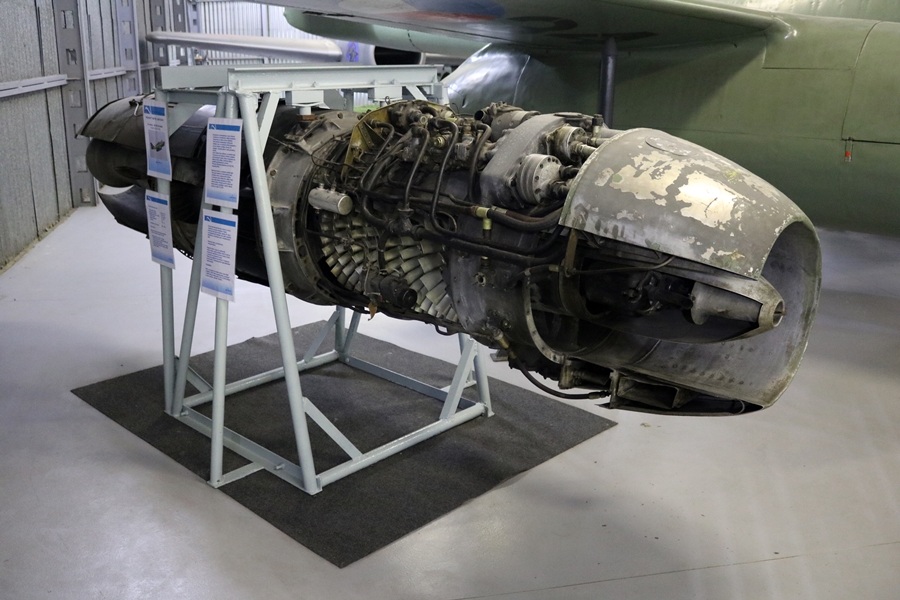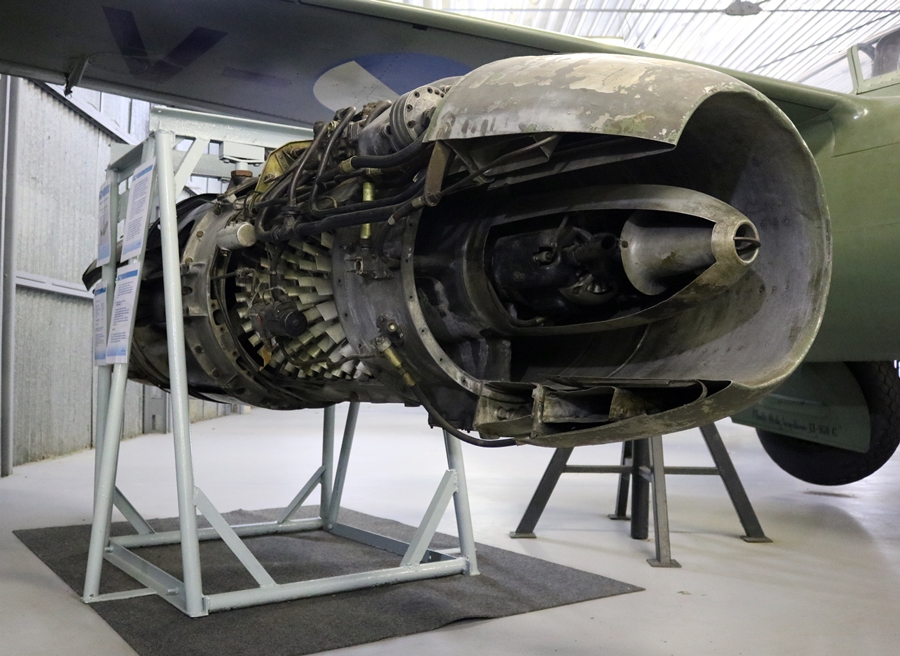By 1945 a number of German Luftwaffe Messerschmitt Me 262 Schwalbe (“Swallow“) jet fighters were located in Czechoslovakia. During the German occupation period Me 262 airframe components were produced by Avia and other Czechoslovakian factories produced jet engine parts and even final assembly of the jet fighter. As a result blueprints, technical manuals, production facilities, numerous spare parts, Junkers Jumo 004 axial-flow turbojet engines and a number of usable Me 262 airframes were available to bolster the Czechoslovakian Air Force after the end of World War Two.
Plans were quickly put into place to complete as many aircraft as possible and bring the Czechoslovakian Air Force into the jet age. The first Czechoslovakian built Me 262A-1a jet fighter was completed by Avia as early as December 1945 and were designated as the Avia S-92 Turbina (“Turbine”).

The first S-92 test flight was conducted on August 27th, 1946 by Antonin Krause, Avia’s chief test pilot. Apparently this aircraft later crashed in September 1946 but this setback did not stop further Czechoslovakian production of their first jet aircraft!
Just 7 Avia S-92 (Me 262A-1a) single seat fighters were completed (the first prototypes were S-92.1, S-92.2 and one following aircraft was trialled unsuccessfully with BMW 003 turbojet engines but reverted back to the Jumo 004B). They were part for part copies of the German fighter and had the same standard armament of four Mk 108 30mm cannons. A further 3 Me 262B-1a two-seat trainers, designated as the Avia CS-92 were also produced (the first flew on December 10th, 1946).

The Junkers Jumo 004B axial-flow jet engines were refurbished by Avia and designated M-04. Although the engines suffered a short life span like their wartime German counterparts, in peacetime Czechoslovakian pilots could apparently coax 60 flying hours with careful control management and constant maintenance before a complete overhaul was required (due to a wartime lack of high quality metals, the German engines generally had an operational lifetime of just 30-50 hours!). Speed wise the S-92 performed about the same as the wartime Me 262 with a maximum speed of 870 km/h (540 mph).
The first Avia S-92 fighters were delivered to the air force in 1947 but a full squadron was not formed for a few years. The Czech 5th Fighter Squadron flew the S-92/CS-92 from Kbely Airbase from 1950 to train pilots in the new age of jet flying. Soon enough though the Soviet Union began to provide access to modern turbojet powered combat and training aircraft such as the Mikoyan Gurevich MiG-15/MiG-15UTI to Czechoslovakia, which far outperformed the World War Two era axial-flow turbojet engines. By 1951 the Avia S-92/CS-92 aircraft were relegated to ground instructional airframes at various schools around the country.

Today you can see the last two surviving aircraft in the impressive collection of the Prague Aviation Museum in Kbely (where they were once operationally based) – a S-92 fighter (Me 262A-1a) and a CS-92 trainer (Me 262B-1a). I was able to see both aircraft during a visit to the museum in September 2017. Unfortunately they are not displayed together as the S-92 is in a Cold War jets gallery and the CS-92 is within the World War Two gallery.



The Avia S-92 (V-34) at the museum was the fourth produced and upon retirement had been in the National Technical Museum collection until transferred to the aviation museum in 1979. Restoration of this aircraft was completed by museum staff in 1987. This one is displayed in Czechoslovakian livery and markings but the gun armament was removed at some point and the gun ports have been covered over. Perhaps they were removed in its ground instructional airframe days? The Junkers Jumo 004B axial-flow jet engine (M-04) displayed with the aircraft was cutaway as a training aid.






Avia CS-92 Turbina
At the end of its operational flying life, the two-seat Avia CS-92 (V-35) on display at the museum became a ground instructional airframe at the Military Technical Academy in Brno. Although transferred to the aviation museum collection in 1967, no major restorative work was commenced until 2009, then it went back into storage.




It is great to see this aircraft well preserved and on display, unfortunately at some stage it was repainted and presented not in its original Czechoslovakian Air Force livery and markings but in a German Luftwaffe scheme! It is painted to represent an aircraft found at Žatec after the war had ended.




I appreciate the heritage of the Avia CS-92 is the German Luftwaffe Messerschmitt Me 262B-1a but I think it would have been better to highlight the moment the Avia aircraft had in history and present it in Czechoslovakian Cold War era livery. A small gripe though in what is a fantastic museum collection!
References:
Classic Wings – Preserved Axis Aircraft (Me 262)

I didn’t know any of that so thanks a lot for sharing it. And with the bonus of a glorious Gloster Meteor in the background in some of the photographs!
LikeLiked by 1 person
Thanks. Cold War oddities and classics
LikeLike
Another fascinating and informative post that we learn from again. I often wonder how similar, or different the Jumo jet engines are to those in the Meteor?
LikeLiked by 1 person
Thank Colin. The Rolls-Royce Derwent is very different in appearance and design
LikeLike
Rolls Royce ‘Whittle” engines used a complicated airflow system of ringed Mini compressors arrainged in a circle on the very front of the engine (think 10 little coffie cans) while the German engines used Ohein’s Axelflow design which kept the air moving through the engine in a straight line.
LikeLike
As always, your posts are educational, Deano. Thanks.
LikeLiked by 1 person
Thanks
LikeLiked by 1 person
We marvel at this technology in its time but glad that WW2 ended when it did because Nazi regime technology was advancing at a rapid rate.
LikeLiked by 1 person
Very true and it formed the basis of Allied design concepts for the next decade!
LikeLike
Thank you for great post.
LikeLiked by 1 person
Thanks John
LikeLike
You are likely to be aware of the handful of reproduction Me 262’s flying around however there is a genuine ME262 with RESTORED Jumo 004 jet engines coming close to completion
Se below link for more
http://warbirdsnews.com/warbird-restorations/paul-g-allens-messerschmitt-me-262-progress-report.html
LikeLiked by 1 person
Thanks John, yes, I have a post on the Me 262 and replicas too on my Survivors page – the Paul Allen example is an exciting prospect!
LikeLike
I’ve seen two seat ME-262 aircraft referred to as “trainers”. Other sources and even wartime German training films available on YouTube seem to indicate that these aircraft were flown by very experienced “Experten” pilots who didn’t need someone sitting behind them teaching them how to fly. In fact, most of the pilots who flew the fighter version were aces ten to thirty times over and required just a simple run-thru of the engine controls and cautions lasting 15 or 20 minutes just prior to their first flight. Other sources have stated that the two seat versions were made to carry a radar operator in the back seat to allow for operations as a night fighter. The latter explanation for the additional seat makes more sense to me.
LikeLike
Much like today, pilots still train to fly in combat trainer variants of the F-15, F-16, F/A-18, MiG-29, Su-27 etc. Many of pilots were some of the best the Luftwaffe had but they had never flown a jet before. They wouldnt have had much time to train but I guess some stick time was better than none. The night fighters were a variant of the trainer – an example survives today in South Africa. In the case of the Czech aircraft they were two-seat trainers.
LikeLike
Did the Czech CS92 retairn the guns and gun ports ? Any external differences to the Me262B ?
LikeLiked by 1 person
I believe they did but had removed them for some reason on this example. Essentially a straight copy straight off the German production line / drawing board.
LikeLiked by 1 person